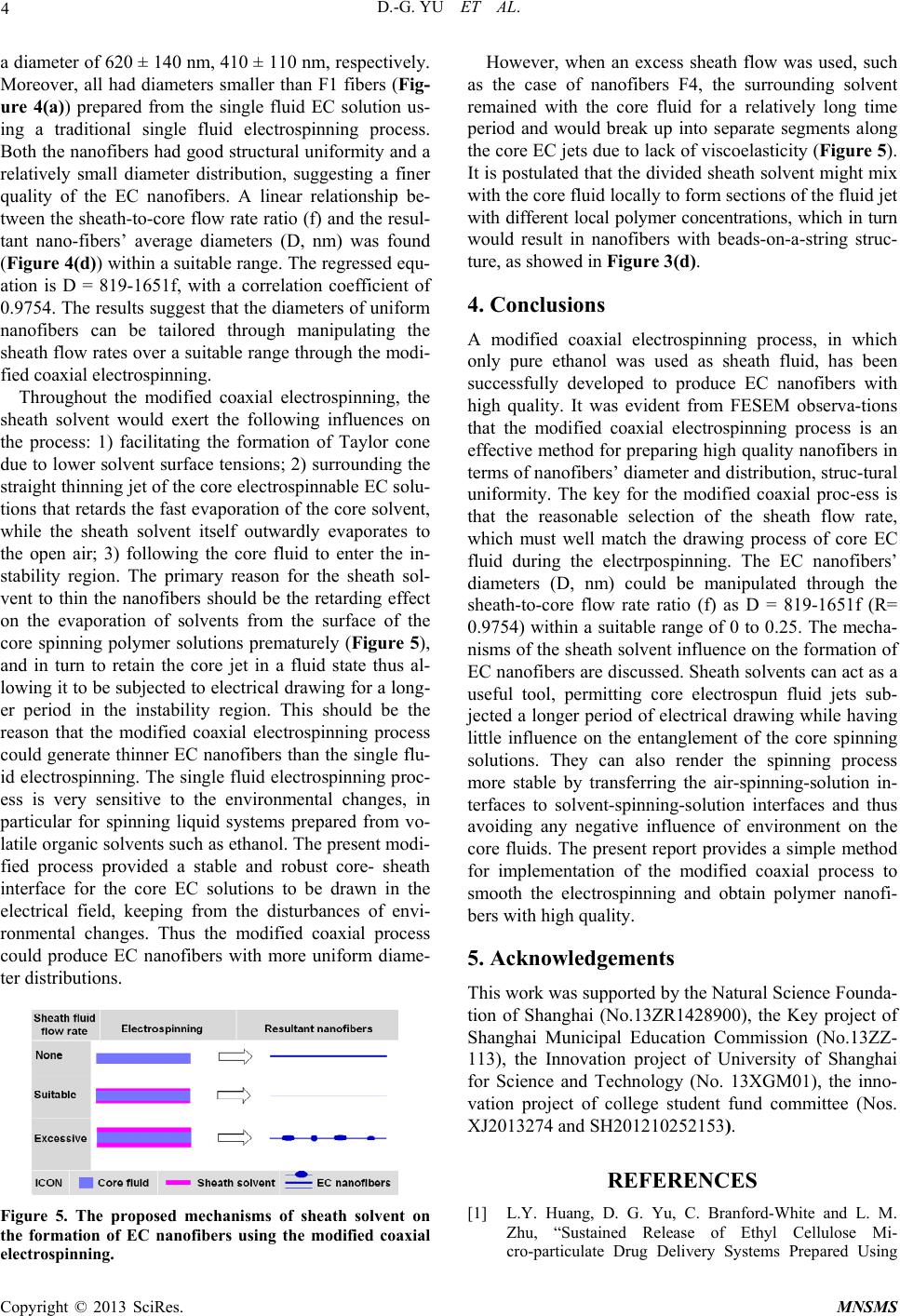
D.-G. YU ET AL.
4
a diameter of 620 ± 140 nm, 410 ± 110 nm, respectively.
Moreover, all had diameters smaller than F1 fibers (Fig-
ure 4(a)) prepared from the single fluid EC solution us-
ing a traditional single fluid electrospinning process.
Both the nanofibers had good structural uniformity and a
relatively small diameter distribution, suggesting a finer
quality of the EC nanofibers. A linear relationship be-
tween the sheath-to-core flow rate ratio (f) and the resul-
tant nano-fibers’ average diameters (D, nm) was found
(Figure 4(d)) within a suitable range. The regressed equ-
ation is D = 819-1651f, with a correlation coefficient of
0.9754. The results suggest that the diameters of uniform
nanofibers can be tailored through manipulating the
sheath flow rates over a suitable range through the modi-
fied coaxial electrospinning.
Throughout the modified coaxial electrospinning, the
sheath solvent would exert the following influences on
the process: 1) facilitating the formation of Taylor cone
due to lower solvent surface tensions; 2) surrounding the
straight thinning jet of the core electrospinnable EC solu-
tions that retards the fast evaporation of the core solvent,
while the sheath solvent itself outwardly evaporates to
the open air; 3) following the core fluid to enter the in-
stability region. The primary reason for the sheath sol-
vent to thin the nanofibers should be the retarding effect
on the evaporation of solvents from the surface of the
core spinning polymer solutions prematurely (Figure 5),
and in turn to retain the core jet in a fluid state thus al-
lowing it to be subjected to electrical drawing for a long-
er period in the instability region. This should be the
reason that the modified coaxial electrospinning process
could generate thinner EC nanofibers than the single flu-
id electrospinning. The single fluid electrospinning proc-
ess is very sensitive to the environmental changes, in
particular for spinning liquid systems prepared from vo-
latile organic solvents such as ethanol. The present modi-
fied process provided a stable and robust core- sheath
interface for the core EC solutions to be drawn in the
electrical field, keeping from the disturbances of envi-
ronmental changes. Thus the modified coaxial process
could produce EC nanofibers with more uniform diame-
ter distributions.
Figure 5. The proposed mechanisms of sheath solvent on
the formation of EC nanofibers using the modified coaxial
electrospinning.
However, when an excess sheath flow was used, such
as the case of nanofibers F4, the surrounding solvent
remained with the core fluid for a relatively long time
period and would break up into separate segments along
the core EC jets due to lack of viscoelasticity (Figure 5).
It is postulated that the divided sheath solvent might mix
with the core fluid locally to form sections of the fluid jet
with different local polymer concentrations, which in turn
would result in nanofibers with beads-on-a-string struc-
ture, as showed in Figure 3(d).
4. Conclusions
A modified coaxial electrospinning process, in which
only pure ethanol was used as sheath fluid, has been
successfully developed to produce EC nanofibers with
high quality. It was evident from FESEM observa-tions
that the modified coaxial electrospinning process is an
effective method for preparing high quality nanofibers in
terms of nanofibers’ diameter and distribution, struc-tural
uniformity. The key for the modified coaxial proc-ess is
that the reasonable selection of the sheath flow rate,
which must well match the drawing process of core EC
fluid during the electrpospinning. The EC nanofibers’
diameters (D, nm) could be manipulated through the
sheath-to-core flow rate ratio (f) as D = 819-1651f (R=
0.9754) within a suitable range of 0 to 0.25. The mecha-
nisms of the sheath solvent influence on the formation of
EC nanofibers are discussed. Sheath solvents can act as a
useful tool, permitting core electrospun fluid jets sub-
jected a longer period of electrical drawing while having
little influence on the entanglement of the core spinning
solutions. They can also render the spinning process
more stable by transferring the air-spinning-solution in-
terfaces to solvent-spinning-solution interfaces and thus
avoiding any negative influence of environment on the
core fluids. The present report provides a simple method
for implementation of the modified coaxial process to
smooth the electrospinning and obtain polymer nanofi-
bers with high quality.
5. Acknowledgements
This work was supported by the Natural Science Founda-
tion of Shanghai (No.13ZR1428900), the Key project of
Shanghai Municipal Education Commission (No.13ZZ-
113), the Innovation project of University of Shanghai
for Science and Technology (No. 13XGM01), the inno-
vation project of college student fund committee (Nos.
XJ2013274 and SH201210252153).
REFERENCES
[1] L.Y. Huang, D. G. Yu, C. Branford-White and L. M.
Zhu, “Sustained Release of Ethyl Cellulose Mi-
cro-particulate Drug Delivery Systems Prepared Using
Copyright © 2013 SciRes. MNSMS